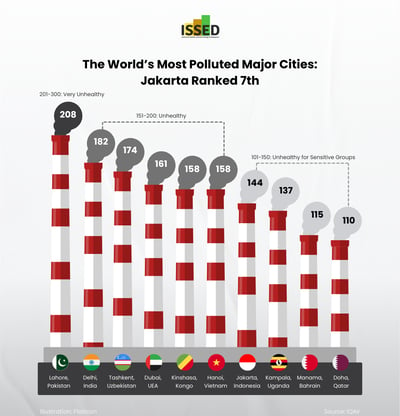The World’s Most Polluted Major Cities: Jakarta Ranked 7th
INFOGRAPHICS
11/24/2024
Indonesia continues to face serious challenges related to air pollution, especially in urban areas. Ranked the 14th most polluted country in the world in 2023, Indonesia has a high concentration of PM2.5 at 37.1 µg/m³. PM2.5 is one of the most dangerous air pollutants, as its tiny size can enter the lungs and cause a range of health problems, from respiratory disorders to cardiovascular disease. These findings show that despite efforts to reduce pollution, air quality in Indonesia is still a major concern, especially in large, densely populated cities.
Globally, Bangladesh has been listed as the country with the worst air quality for several years in a row with astounding PM2.5 levels reaching nearly 80 µg/m³. In comparison, PM2.5 concentrations in Indonesian urban areas such as South Tangerang exceed even some of the most polluted countries with an alarming 71.7 µg/m³, signaling poor air conditions for more than a million residents. Tangerang, Bekasi and Jakarta are also among the most polluted cities in Indonesia, illustrating that rapid urbanization often comes at a high price for environmental and public health. Interestingly, data from cities like Banda Aceh and Kupang, which are far from the hustle and bustle of heavy urbanization, show that the air in these regions is much cleaner. Banda Aceh recorded 9.8 µg/m³ and Kupang was even lower, at only 4.6 µg/m³. This shows how important it is for environmental policies to focus on controlling urbanization and maintaining the environment, so that big cities can follow in the footsteps of smaller cities with better air quality.
In Southeast Asia, Indonesia remains to be the country with the worst air quality, outperforming neighboring countries such as Malaysia and Singapore which have much lower PM2.5 concentrations, 22.5 µg/m³ and 13.4 µg/m³ respectively. This phenomenon confirms that in addition to urbanization, Indonesia needs to pay attention to industrial emissions, transportation, and forest fires that often occur, especially in the dry season.
Although there was a downward trend in pollution from 2018 to 2022, the increase again in 2023 needs to be watched out for. The increase from 30.4 µg/m³ in 2022 to 37.1 µg/m³ in 2023 indicates that the efforts made are still not enough to maintain the positive trend. This should serve as an alarm to policymakers that more aggressive action is needed to address the major sources of pollution across the country.
These are not just numbers. This data speaks to the health of millions of people who are exposed to poor air quality every day. The lurking health risks don't just affect quality of life today. Air pollution is responsible for around 1 in 9 deaths worldwide, making it the biggest environmental threat to human health. WHO estimates that air pollution causes around 7 million premature deaths worldwide every year. Therefore, investing in clean energy, green infrastructure, and stricter environmental policies is no longer an option, but a necessity.


